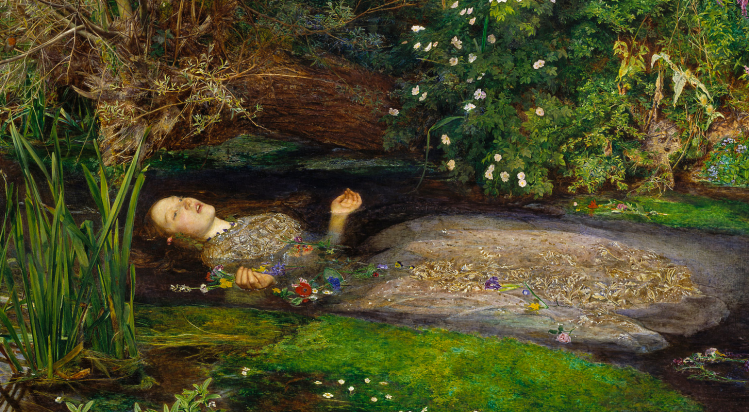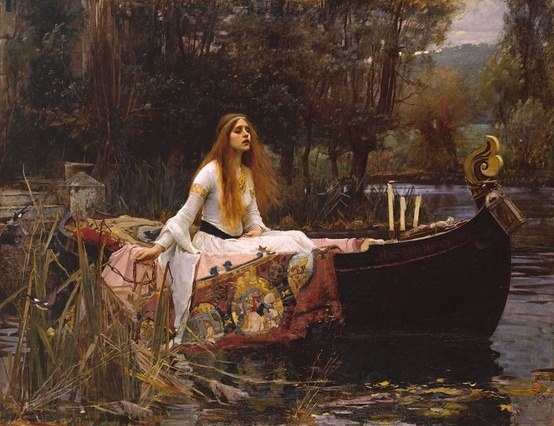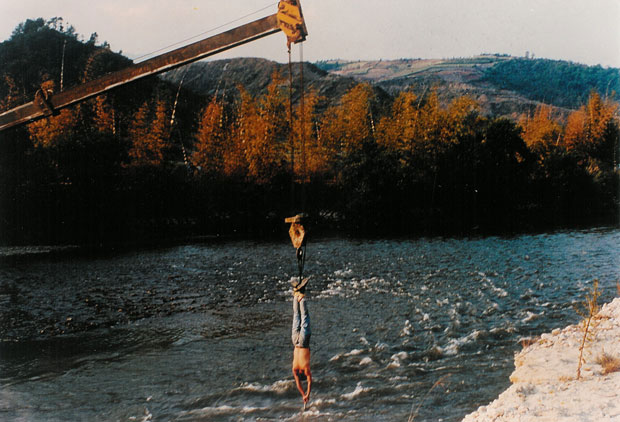One week into our acclimatisation process for River, we can feel a transition starting to happen. The water that once felt frigid to our bodies is somehow becoming part of our own viscera, as if we can feel its swelling current shifting within us. As a vessel that consists of 50-65% water, the body is replete with its own pools, currents and outflows, yet these are sensations that we rarely draw our attention towards. As we rest in the water, feeling its flow and its energy, it is as if a merging takes place; the currents of inside and outside combining. From this origin of joining, we feel movements taking place, not as an element that is imposed onto the water, but one that emanates as a mutual flux.
The effects of the rehearsal process in River reminds me very much of an exercise I read years ago in 101 Experiments in the Philosophy of Everyday Life, by Roger-Pol Droit. The experiment reads:
13. Drink while Urinating
Duration: 1-2 minutes
Props: Toilet and a glass of water
Effect: Wide open
Pol-Droit invites the reader to drink as continuously as possible whilst urinating, stating ‘as far as possible you should try to drink the water straight down without pausing.’ He continues:
The water you evacuate seems to be synchronized with that entering your mouth […] in a few seconds you will feel directly wired, from throat to urethra […] No more intestine, no kidneys, no filtration time, no waiting. Water pours through you vertically […] Your system seems to have opened inside out […] the cosmic flux or an automatic washing machine (2001: 28-29)
I didn’t ever get around to trying the exercise but what we have found whilst working in the river is the overwhelming urge to open our mouths and let the water flow in. In the knowledge that doing so would be unsafe, we skim our open mouths just above the surface, a gesture of compliance to our physiological desire. And so it is that every day we have rehearsed in the river to date, it has rained, reminding us to the origins of the river at the Wells of Dee on Braeriach plateau: we open our mouth to the rain also – the river is flowing through us.
The earliest origins of the name of the Dee can be sourced to Claudius Ptolemy in the second century AD. A geographer from Alexandria, Ptolemy dubbed the Dee as Δηοῦα (=Deva), meaning ‘Goddess’. Indeed, mythologies of water and the concepts of purification, healing and fertility are widespread. The Greek Goddess Aphrodite was born in the ocean, while the seductive call of Sirens and the Celtic legend of Selkies are testament to the connection between femininity and water. It is perhaps no coincidence then, that the site where we find ourselves, so-called Lover’s Walk, was a place at which unseen trysts took place. The Dee was a location of retreat and romance for yearning couples wishing to escape for a private moment among the trees. The many tree carvings by couples along the route at Lover’s Walk provide echoes of these deep, unknowable pasts.
One of our starting points for visual imagery while rehearsing River has stemmed from the iconic imagery found in Pre-Raphaelite painting. Rossetti’s 1853 painting Boatman and Siren depicts the peril of a fisherman being lured to death by the irresistible draw of a water woman, while Aloysius Bertrand’s first poem from Gaspard de La Nuit tells of a soldier who is beckoned into the water by nymph Ondine in exchange for everlasting life. Originally appearing in Ovid’s Metamorphoses, Ondine appears in water falls and pools with the necessity to gain immortality by marrying a human, and she though human in appearance, lacks a soul, and so has no affection for him. In Orphelia, a painting completed by Sir John Everett Millais between 1851-52, a young girl is seen floating immediately before she drowns, singing with her face turned towards the sky. Taken from a description in Act IV, Scene VII of Shakespeare’s Hamlet, Orphelia falls into the river from an overhanging tree while collecting flowers, her clothes allowing her to stay temporarily afloat.

The Lady of Shalott, painted by John William Waterhouse in 1888, is another haunting image of an ill-fated lady floating to her death in a rowing boat, a story that originates in Lord Alfred Tennyson’s poem by the same name. As the story goes The Lady was forbidden to look directly at reality but instead had to watch the world through a mirror, the images of which she would then weave into a tapestry. Agonised by the image of lovers intertwined in the distance, she sees Sir Lancelot passing in the mirror and turns to look directly at Camelot. In fear that a curse will be upon her, The Lady escapes by boat during an autumn storm, singing as she sails to certain death.

These images, coupled with our work in the River, recalled to mind a Chinese performance artist I met in 2006 named He Yunchang. In his work, Yunchang troubles the relationship between environment and body through a series of actions as diverse as publically removing one of his own ribs and sitting in the middle of the Niagara Falls for twenty-four hours. Listening to Yunchang talk I was immediately struck by two of Yunchang’s works.
In the first, Take Dialogue with Water (1999), Yunchang was suspended upside down from a crane above the Liang River, in Yunan. Prior to suspension, a butcher made two 2cm incisions in each of his upper arms. During the suspension, which lasted a total of thirty minutes, the blood from these incisions flowed into the river, while Yunchang held the butcher’s knife between his hands cutting into the water. He estimates that throughout this duration he ‘sliced through’ 4,500m length of the river.

In the second performance, River Document (Shanghai, 2000), Yunchang spent ten hours moving ten tons of water of the Suzhou Creek upstream via water hand bucketed into a boat. In this way he suggests that he caused the ‘river to reverse flow for 5 kilometres’. Yunchang’s work enables us to think of the river as an entity that can be transported, divided and reunified. In our work this has become a major theme that has been metamorphosed through the concept of two river entities that represent two aspects of one person. This is a duality and a polarity that is presented by the water itself: the river runs in currents and tributaries, yet it is a unified whole. It is a place of calm and beauty as well as a place of danger and death.
Through meeting with the various community groups in Peterculter such as Knit & Knatter, we have been able to collect a wealth of stories surrounding the river Dee that we have been able to feed into our choreographic process. Our dear friend Boaty Maggie has put in a frequent appearance, her presence like a phantom over the movements we create. Her counterpart, or sister-twin, Isabel, was also known to transport people in a rowing boat across the river to Maryculter. As the story goes, a wire to stop the current carrying her away tethered Maggie’s boat. The Order of Knight’s Templar at Maryculter, established in 1187 by King William the Lion for French Soldiers during Crusades, adds a further mythological dimension, connecting local legend to images such as The Lady of Shalott. One of the only few remaining survivors of the Titanic, The last Gordon Laird, Sir Cosmo Duff Gordon, lived at Maryculter House up until 1935, when the estate was broken up, giving us a further connection to water and the power that rages within it.
As we build these different elements into our choreography, we find much that is process based and less that is sequenced. Our movements are formed on actions and tasks rather than being set in stone, our reactions to the water, our vocalisations and the physical impulses of the currents arising within us with genuine force. These utterances, these slips and maneuvers, are complicit with the challenges the river presents us with: slippery rocks and bare feet, shifting water levels that rise and sink in keeping with the latest rainfall, the moments where we fall and can no longer keep our balance, the sharing of a fluid that has become internal, the beating of the river that soothes and ignites, and the heron, that quietly sits and waits.
*****
My body is full of fluid
Freezing in your liquid current
Steadily pulsing
Veins contract
Minute internal tributaries
To your gargantuan power.
We had started divided,
Gathering in pools as
One. Single. Trickle.
The warmth of your outflow
Hovering above eagle’s gaze
You soar from the precipice
Drop by drop
Inaccessible to man.
As you gather, you form —
From Braeriach you plunge
Cliff edge to valley floor
Passed Cairn Toul and Macdui.
You pick up speed
Drawing energy from the wilderness around you.
By the Linn you are raging
Murderous and thirsty for children
Plucking lives;
You are silent, and without mercy.
As you descend, we unify
Increasing in speed
We sound out your hidden depths
Lower swells and whirlpools
Sucking and spitting, furious
You are an outcast of yourself
Reluctant to admit
The torrent of hate within you.
As you reach Ballater and Aboyne
You widen and calm,
A mouth-like opening
Swallowing everything in your path.
We enter you and you enter us
Through skin and through some kind of imperceptible creeping
We feel you moving within us
Fluid within and fluid without
Merging, intertwining, inseparable.
We are as you move
Becoming you
Engulfed by you
Carried by you
The raindrops of our tears
Immersed by the outflow
Of your bitter cascade.
As we wait and listen
By your stinging, heartless shore
We hear a distant utterance
A sigh almost scream-like in its serenity
Filtering through the babble of your idle chatter
And the intense droning of your sister channel —
The Goddess has her breath taken from her.
— Imogene Newland